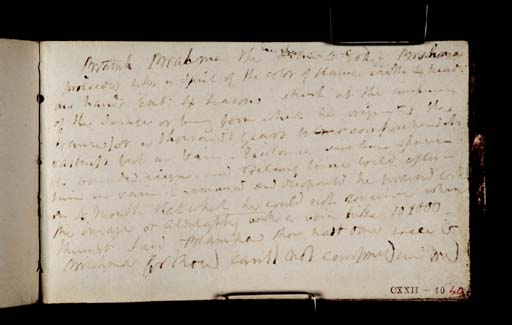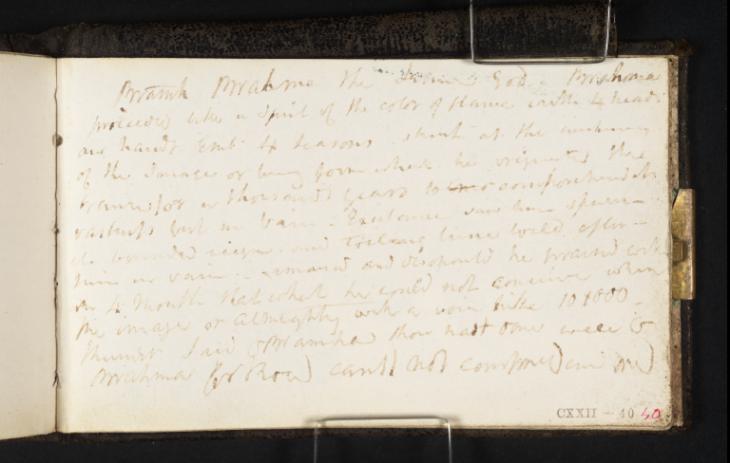Joseph Mallord William Turner Inscription by Turner: Notes from Alexander Dow's 'Customs, Manners, Language, Religion and Philosophy of the Hindoos' c.1807-14
Image 1 of 2
-
 Joseph Mallord William Turner, Inscription by Turner: Notes from Alexander Dow's 'Customs, Manners, Language, Religion and Philosophy of the Hindoos' c.1807-14
Joseph Mallord William Turner, Inscription by Turner: Notes from Alexander Dow's 'Customs, Manners, Language, Religion and Philosophy of the Hindoos' c.1807-14 -
 Joseph Mallord William Turner, Inscription by Turner: Notes from Alexander Dow's 'Customs, Manners, Language, Religion and Philosophy of the Hindoos' c.1807-14 (Enhanced image)Enhanced image
Joseph Mallord William Turner, Inscription by Turner: Notes from Alexander Dow's 'Customs, Manners, Language, Religion and Philosophy of the Hindoos' c.1807-14 (Enhanced image)Enhanced image
Joseph Mallord William Turner,
Inscription by Turner: Notes from Alexander Dow's 'Customs, Manners, Language, Religion and Philosophy of the Hindoos'
c.1807-14
Joseph Mallord William Turner 1775–1851
Folio 40 Recto:
Inscription by Turner: Notes from Alexander Dow’s ‘Customs, Manners, Language, Religion and Philosophy of the Hindoos’ c.1807–14
D08346
Turner Bequest CXXII 40
Turner Bequest CXXII 40
Pen and ink on white wove paper, 69 x 112 mm
Inscribed by Turner in pen and ink (see main catalogue entry)
Inscribed by John Ruskin in red ink ‘40’ bottom right
Stamped in black ‘CXXII – 40’ bottom right
Inscribed by Turner in pen and ink (see main catalogue entry)
Inscribed by John Ruskin in red ink ‘40’ bottom right
Stamped in black ‘CXXII – 40’ bottom right
Accepted by the nation as part of the Turner Bequest 1856
References
1909
A.J. Finberg, A Complete Inventory of the Drawings of the Turner Bequest, London 1909, vol.I, p.341, CXXII 40, as ‘MS. note about Brahma, who “proceedeth like a spirit of the color of flame with four heads,” &c.’.
1981
Evelyn Joll, ‘Yorkshire Symposium’, Turner Studies, vol.1, no.1, Summer 1981, p. 42.
1981
William Chubb, ‘Minerva Medica and The Tall Tree’, Turner Studies, vol.1, No.2, Winter 1981, pp.28, 34–5.
1990
Kathleen Nicholson, Turner’s Classical Landscapes: Myth and Meaning, Princeton 1990, pp.152, 213 note 16.
1997
Anthony Bailey, Standing in the Sun: A Life of J.M.W. Turner, London 1997, p.161.
The whole page is taken up with the following notes in ink:
Brahm Bramhe the [?dawn] God. Brahma | proceeded like a spirit of the color of flame with 4 heads | and hands [?Emb] 4 seasons struck at the immensity | of the Image or [?living] form what he originates [?He] | travels for a thousands years to comr comprehend its | vastness but in vain. Existence saw him [?spurn –] | its [...]ed reign, and [...] after – | him in vain – amazed and [?disapointed] he praised with | [?the] 4 Mouth that which he could not conceive when | the image or Almighty with a voice like 10 1000 | thunder said Brahma thou has done well O | Brahma for thou canst not comprehend me1
William Chubb has identified this as taken from ‘A Dissertation Concerning the Customs, Manners, Language, Religion and Philosophy of the Hindoos’ by the Orientalist Alexander Dow (1735/6–1779), in the first volume of his 1768 History of Hindostan.2 He quotes Dow’s text as follows:
Brihm existed from all eternity, in a form of infinite dimensions. When it pleased him to create the world, he said, Rise up, O Brimha. Immediately a spirit of the colour of flame issued from his navel, having four heads and four hands, Brihm gazing round, and seeing nothing but the immense image, out of which he had proceeded, he travelled a thousand years to endeavour to comprehend its dimensions. But after all his toil, he found himself as much at a loss as before.
Lost in amazement, Brimha gave over his journey. He fell prostrate and praised what he saw, with his four mouths. The almighty, then, with a voice like ten thousand thunders, was pleased to say: Thou hast done well, O Brimha, for thou canst not comprehend me! Go and create the world. How can I create it? Ask of me, and power shall be given unto thee. O God, said Brimha, thou art almighty in power!3
There are further passages concerning non-Christian religions on folios 41 recto and 42 recto (D08348, D08350). Chubb has suggested that Turner might have had access to at least one of the texts through patrons with antiquarian interests such as Sir Richard Colt Hoare or Richard Payne Knight;4 he has related those here and on D08348 to Turner’s interest in India, and in particular his Introduction of apparently Hindu Indian figures in the otherwise classical European landscapes of two subjects in the Liber Studiorum series of landscape engravings.5
See the present author’s entries for the watercolour studies relating to the Liber subjects elsewhere in this catalogue: The Temple of Minerva Medica (‘Hindoo Devotions’ or ‘The Hindoo Worshipper’) of about 1808 (Tate D08128; Turner Bequest CXVII A), published in 1811 (Tate impressions: A00956, A00957); and Scene in the Campagna (‘Woman at a Tank’ or ‘Hindoo Ablutions’), sometimes also called ‘The Tall Tree’, also of about 1808 (Tate D08141; Turner Bequest CXVII N), published in 1812 (Tate impressions: A00986, A00987). Chubb notes the presence of drawings in this sketchbook which may be from 1807 or earlier (see under folio 9 recto; D08297), implying that the notes here could have preceded and informed the two Liber designs.6
Matthew Imms
September 2013
Chubb 1981, pp.34–5; transcribed in turn from the reprinted text in P.J. Marshall, The British Discovery of Hinduism in the Eighteenth Century, Cambridge 1970, p.125.
How to cite
Matthew Imms, ‘Inscription by Turner: Notes from Alexander Dow’s ‘Customs, Manners, Language, Religion and Philosophy of the Hindoos’ c.1807–14 by Joseph Mallord William Turner’, catalogue entry, September 2013, in David Blayney Brown (ed.), J.M.W. Turner: Sketchbooks, Drawings and Watercolours, Tate Research Publication, September 2014, https://www

